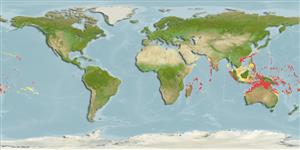Common names from other countries
Teleostei (teleosts) >
Holocentriformes (Squirrelfishes, soldierfishes) >
Holocentridae (Squirrelfishes, soldierfishes) > Myripristinae
Etymology: Myripristis: Greek, myros, -ou = male of morey eel + Greek, pristis = saw (Ref. 45335).
More on author: Valenciennes.
Environment: milieu / climate zone / depth range / distribution range
Ecology
Marine; reef-associated; depth range 3 - 100 m (Ref. 9710), usually 15 - 80 m (Ref. 9710). Tropical; 32°N - 33°S, 42°E - 133°W
Indo-Pacific: mainly from oceanic islands, from the Mascarene Islands and Seychelles to French Polynesia and the Hawaiian Islands.
Size / Weight / Age
Maturity: Lm ? range ? - ? cm
Max length : 25.0 cm TL male/unsexed; (Ref. 30874); max. published weight: 119.00 g (Ref. 124708)
Dorsal spines (total): 11; Dorsal soft rays (total): 13 - 15; Anal spines: 4; Anal soft rays: 11 - 13. Interorbital space broad, 3.3-4.0 in head; inner pectoral axil naked; leading edges of median fins white (Ref 2334); lacks a dark opercular bar (except for perhaps a deeper red).
Found in inshore waters (Ref. 75154). Benthopelagic (Ref. 58302). Forms large aggregations in caves and ledges of steep drop-offs. Nocturnal and feeds on plankton (Ref 1241); also on crabs and fishes (Ref. 9137). Individual is often swimming upside down, even when mixed in schools of non-inverted ones (Ref. 48635). Maximum depth reported taken from Ref. 128797.
Life cycle and mating behavior
Maturities | Reproduction | Spawnings | Egg(s) | Fecundities | Larvae
Randall, J.E. and D.W. Greenfield, 1996. Revision of the Indo-Pacific holocentrid fishes of the genus Myripristis, with descriptions of three new species. Indo-Pac. Fish. (25):61 p. (Ref. 12419)
IUCN Red List Status (Ref. 130435)
CITES (Ref. 128078)
Not Evaluated
Threat to humans
Harmless
Human uses
Fisheries: commercial
Tools
Special reports
Download XML
Internet sources
Estimates based on models
Preferred temperature (Ref.
115969): 24.3 - 28.9, mean 27.2 (based on 474 cells).
Phylogenetic diversity index (Ref.
82804): PD
50 = 0.5000 [Uniqueness, from 0.5 = low to 2.0 = high].
Bayesian length-weight: a=0.01905 (0.00865 - 0.04198), b=3.03 (2.85 - 3.21), in cm Total Length, based on LWR estimates for this Genus-body shape (Ref.
93245).
Trophic level (Ref.
69278): 3.8 ±0.60 se; based on food items.
Resilience (Ref.
120179): High, minimum population doubling time less than 15 months (Preliminary K or Fecundity.).
Fishing Vulnerability (Ref.
59153): Low vulnerability (15 of 100).
